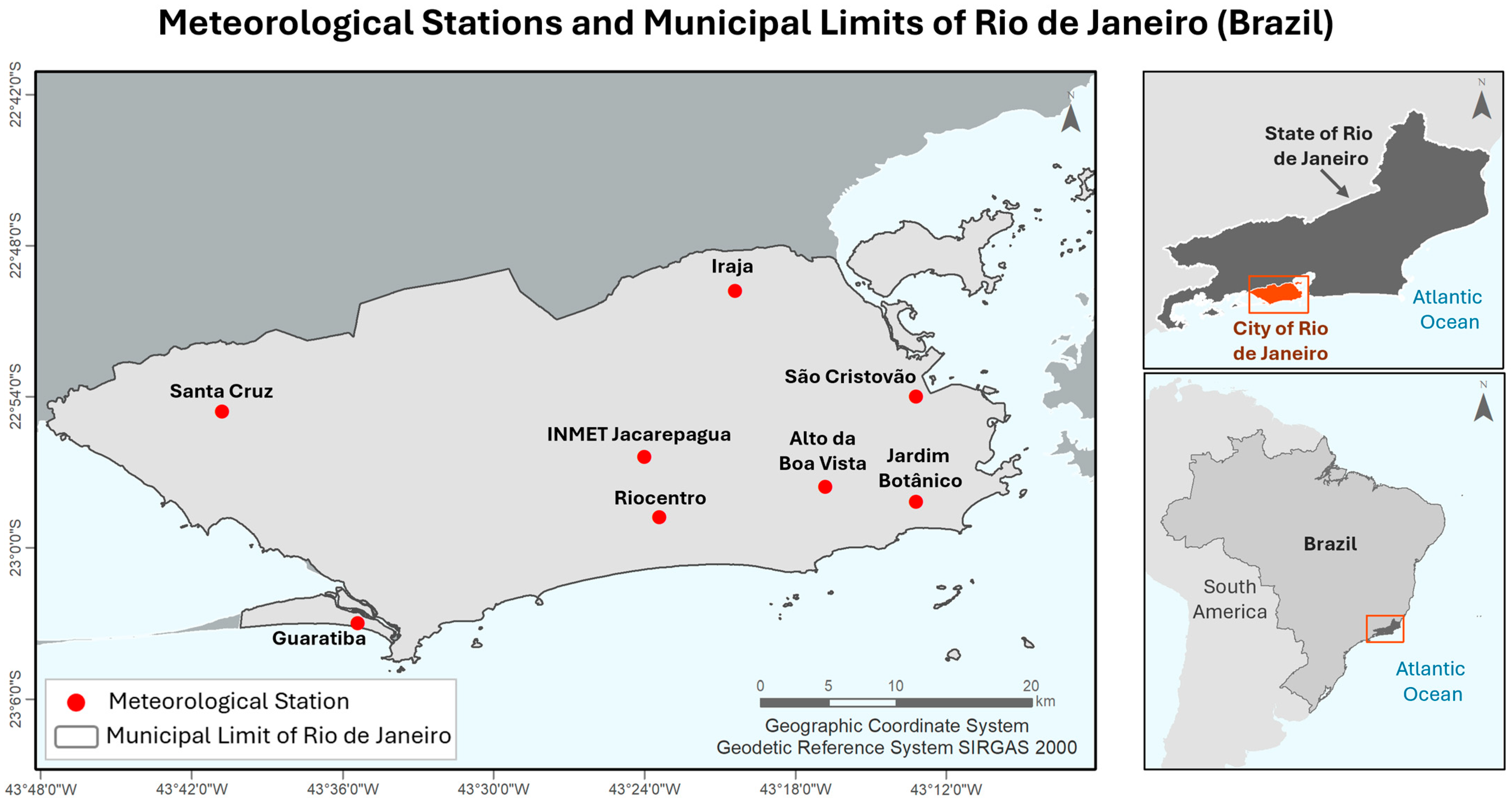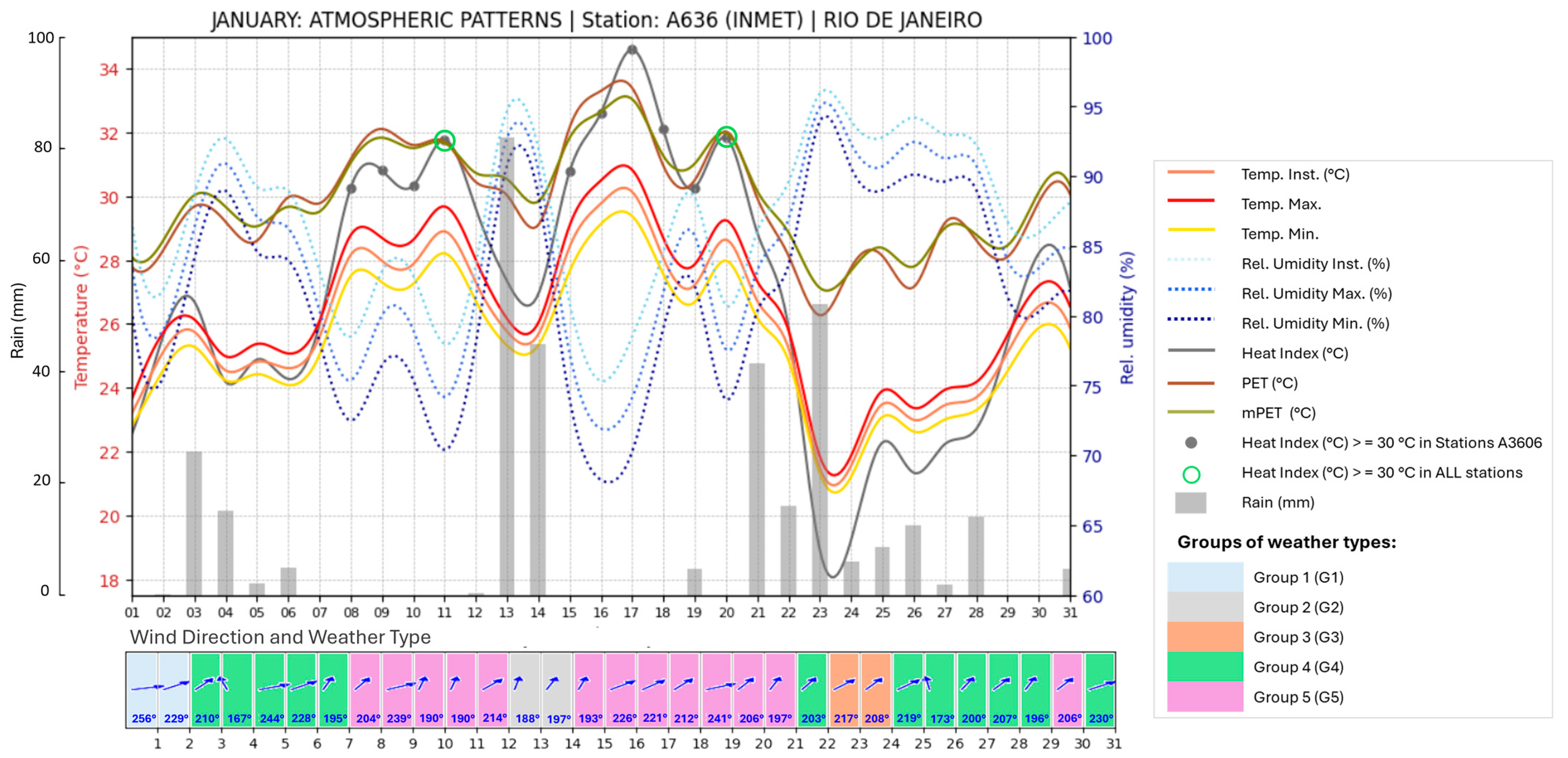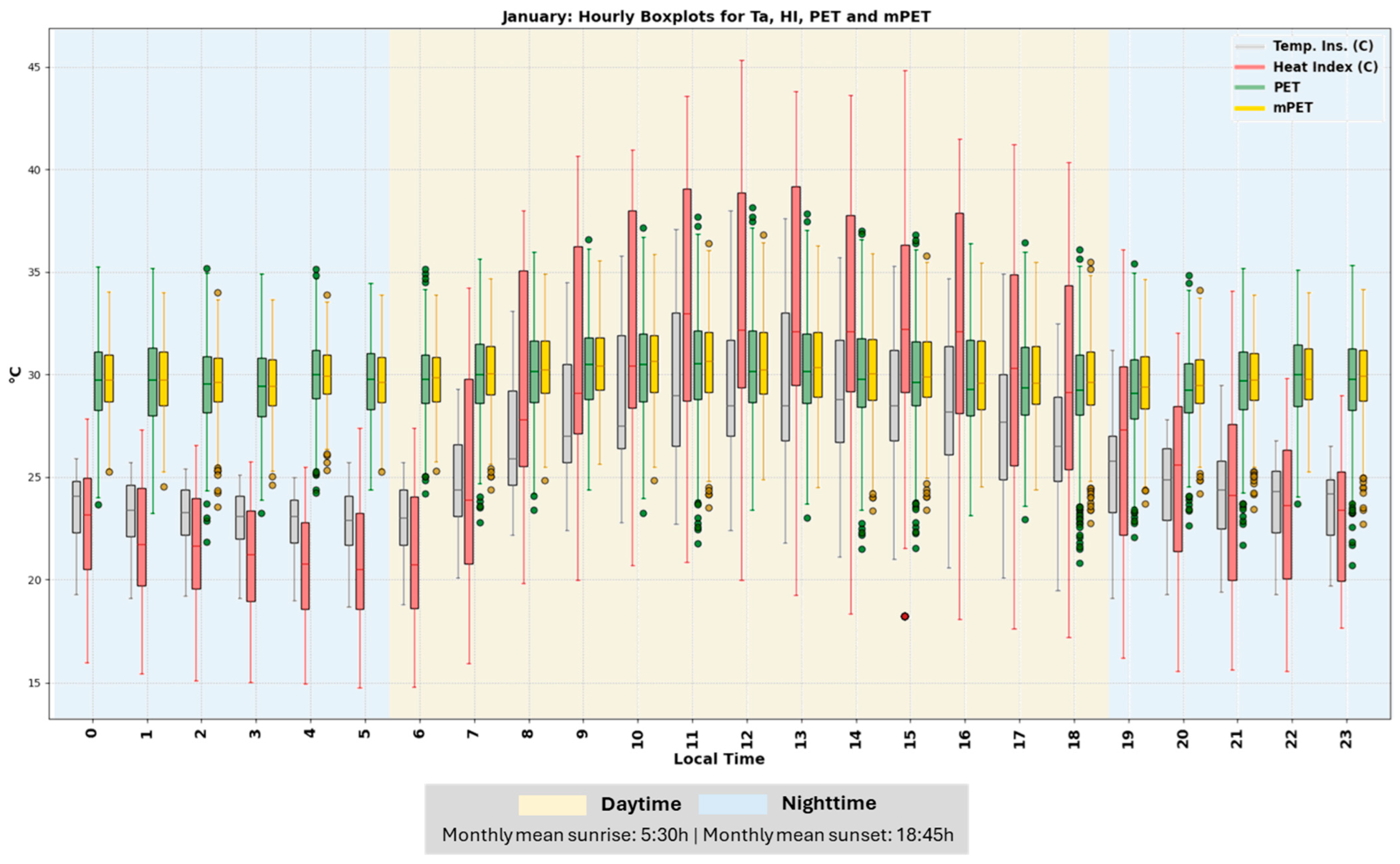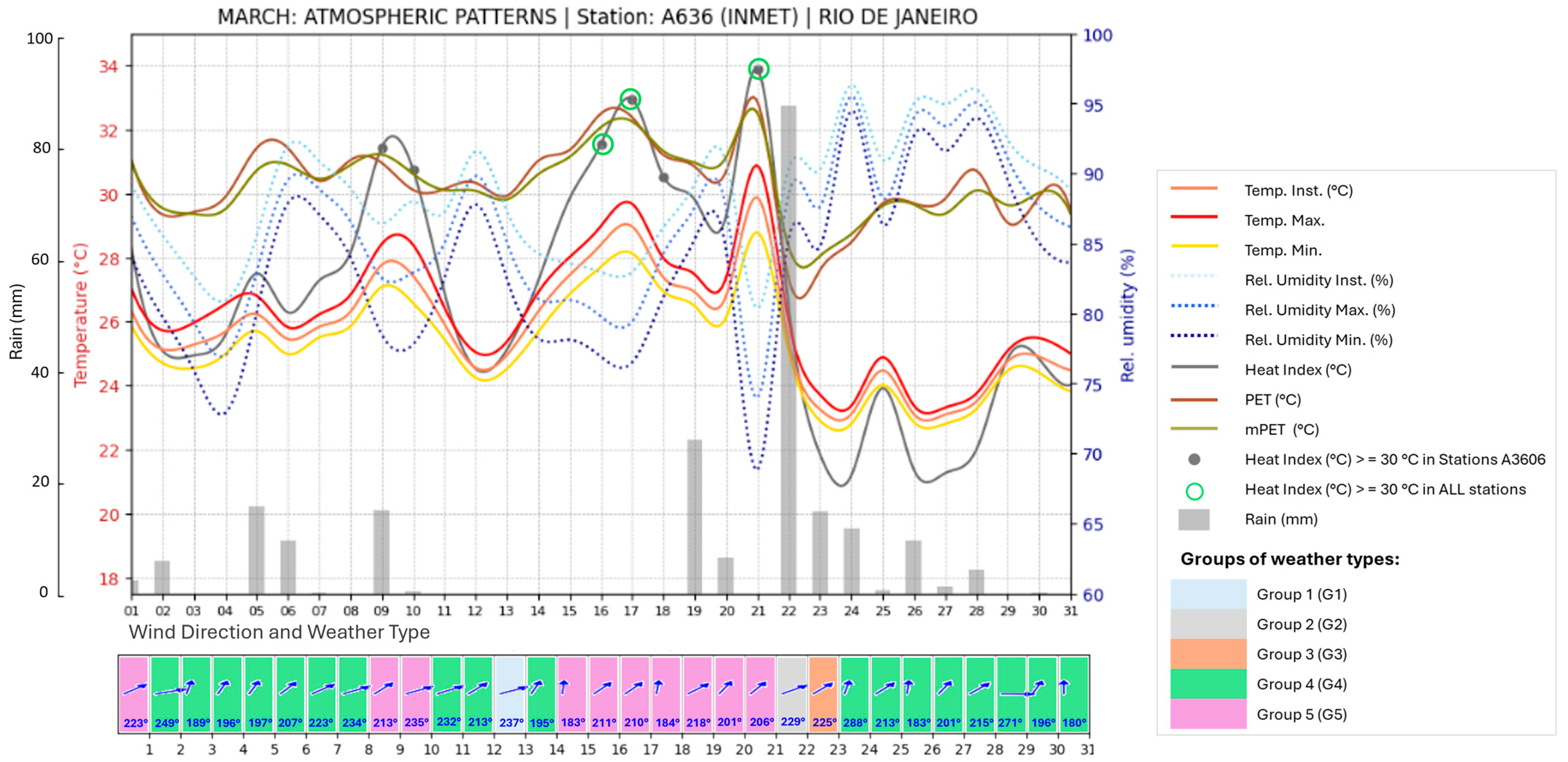Atmospheric Conditions Related to Extreme Heat and Human Comfort in the City of Rio de Janeiro (Brazil) during the First Quarter of the Year 2024
Abstract
:1. Introduction
2. Materials and Methods
2.1. Study Area
2.2. Datasets
2.3. Methodological Procedure
2.3.1. Analysis of Atmospheric Dynamics and Classification of Weather Types
2.3.2. Calculation and Analysis of Thermal Comfort Indices
− 0.00683783 × T × T − 0.05481717 × RH × RH + 0.00122874 × T × T × RH
+ 0.00085282 × T × RH × RH − 0.00000199 × T × T × RH × RH
3. Results
3.1. Weather Types and Air Masses
3.2. Monthly Atmospheric Rhythm and Thermal Comfort Indices’ Variability
4. Discussion
5. Conclusions
Supplementary Materials
Author Contributions
Funding
Institutional Review Board Statement
Informed Consent Statement
Data Availability Statement
Acknowledgments
Conflicts of Interest
References
- IPCC. Climate Change 2023: Synthesis Report. Contribution of Working Groups I, II and III to the Sixth Assessment Report of the Intergovernmental Panel on Climate Change; Core Writing Team, Lee, H., Romero, J., Eds.; IPCC: Geneva, Switzerland, 2023. [Google Scholar] [CrossRef]
- Prosdocimi, D.; Klima, K. Health Effects of Heat Vulnerability in Rio de Janeiro: A Validation Model for Policy Applications. SN Appl. Sci. 2020, 2, 1948. [Google Scholar] [CrossRef]
- Silveira, I.H.; Cortes, T.R.; Bell, M.L.; Junger, W.L. Effects of Heat Waves on Cardiovascular and Respiratory Mortality in Rio de Janeiro, Brazil. PLoS ONE 2023, 18, e0283899. [Google Scholar] [CrossRef] [PubMed]
- Silveira, I.H.; Cortes, T.R.; Oliveira, B.F.A.; Junger, W.L. Temperature and Cardiovascular Mortality in Rio de Janeiro, Brazil: Effect Modification by Individual-Level and Neighbourhood-Level Factors. J. Epidemiol. Community Health 2021, 75, 69–75. [Google Scholar] [CrossRef]
- Berry, P.; Campbell-Lendrum, D.; Corvalan, C.; Guillemot, J. Protecting Health from Climate Change: Vulnerability and Adaptation Assesment, 1st ed.; Ebi, K., Ed.; World Health Organization: Geneva, Switzerland, 2013; ISBN 978-92-4-156468-7. Available online: https://www.who.int/publications/i/item/protecting-health-from-climate-change-vulnerability-and-adaptation-assessment (accessed on 2 May 2024).
- World Meteorological Organization. Provisional State of the Global Climate 2023; WMO: Geneva, Switzerland, 2023; Volume 6, Available online: https://www.un.org/en/climatechange/reports?gad_source=1&gclid=CjwKCAjwnqK1BhBvEiwAi7o0X9ZVol0FF6yR9j-vtXsOt6yqLzD0qUczYnXSLsacS-SIamAkDTjwIhoCrl8QAvD_BwE (accessed on 2 May 2024).
- World Meteorological Organization. State of the Climate in Latin America and the Caribbean 2022; WMO: Geneva, Switzerland, 2022; ISBN 978-92-63-11351-1. Available online: https://reliefweb.int/report/argentina/state-climate-latin-america-and-caribbean-2022?gad_source=1&gclid=CjwKCAjwnqK1BhBvEiwAi7o0X1qzzZ8OIVptBNnQuA0PgI3NM-HCNVnP6xg3XR7OZxp75xEl6A5DhBoCd2cQAvD_BwE (accessed on 2 May 2024).
- Marengo, J.A.; Camargo, C.C. Surface Air Temperature Trends in Southern Brazil for 1960–2002. Int. J. Climatol. 2008, 28, 893–904. [Google Scholar] [CrossRef]
- de Lucena, A.J.; Rotunno Filho, O.C.; de Almeida França, J.R.; de Faria Peres, L.; Xavier, L.N.R. Urban Climate and Clues of Heat Island Events in the Metropolitan Area of Rio de Janeiro. Theor. Appl. Climatol. 2013, 111, 497–511. [Google Scholar] [CrossRef]
- Geirinhas, J.L.; Trigo, R.M.; Libonati, R.; Castro, L.C.O.; Sousa, P.M.; Coelho, C.A.S.; Peres, L.F.; de Avelar, F.M.; Magalhães, M. Characterizing the Atmospheric Conditions during the 2010 Heatwave in Rio de Janeiro Marked by Excessive Mortality Rates. Sci. Total Environ. 2019, 650, 796–808. [Google Scholar] [CrossRef] [PubMed]
- Rusticucci, M. Observed and Simulated Variability of Extreme Temperature Events over South America. Atmos. Res. 2012, 106, 1–17. [Google Scholar] [CrossRef]
- CNN Brasil Calor Sufocante: Com 60.1 °C, Rio Atinge Recorde de Sensação Térmica. Available online: https://www.cnnbrasil.com.br/nacional/calor-sufocante-com-601oc-rio-atinge-recorde-de-sensacao-termica/ (accessed on 2 May 2024).
- Deutsche Welle Brazil Heat Wave Hits Record Temperatures, Rio at 62 °C. Available online: https://www.dw.com/en/brazil-heat-wave-hits-record-temperatures-rio-at-62c/g-68621375 (accessed on 2 May 2024).
- Al Jazeera Record Heat Index of 62.3C Scorches Brazil’s Rio de Janeiro. Available online: https://www.aljazeera.com/gallery/2024/3/18/photos-record-heat-index-of-62-3c-scorches-rio-de-janeiro (accessed on 2 May 2024).
- Câmara, F.P.; Gomes, A.F.; Dos Santos, G.T.; Câmara, D.C.P. Clima e Epidemias de Dengue No Estado Do Rio de Janeiro. Rev. Soc. Bras. Med. Trop. 2009, 42, 137–140. [Google Scholar] [CrossRef] [PubMed]
- Ebi, K.L.; Capon, A.; Berry, P.; Broderick, C.; de Dear, R.; Havenith, G.; Honda, Y.; Kovats, R.S.; Ma, W.; Malik, A.; et al. Hot Weather and Heat Extremes: Health Risks. Lancet 2021, 398, 698–708. [Google Scholar] [CrossRef]
- NCEP. The Heat Index Equation. Available online: https://www.wpc.ncep.noaa.gov/html/heatindex_equation.shtml (accessed on 2 May 2024).
- Höppe, P. The Physiological Equivalent Temperature—A Universal Index. Int. J. Biometeorol. 1999, 43, 71–75. [Google Scholar]
- Höppe, P. Different Aspects of Assessing Indoor and Outdoor Thermal Comfort. Energy Build. 2002, 34, 661–665. [Google Scholar] [CrossRef]
- Chen, Y.C.; Chen, W.N.; Chou, C.C.K.; Matzarakis, A. Concepts and New Implements for Modified Physiologically Equivalent Temperature. Atmosphere 2020, 11, 694. [Google Scholar] [CrossRef]
- Instituto Brasileiro de Geografia e Estatística, I. Cidades e Estados: Rio de Janeiro. Available online: https://cidades.ibge.gov.br/brasil/rj/panorama (accessed on 2 May 2024).
- Instituto Nacional de Meteorologia Normal Climatológica (Período de Referência: 1991–2020). Available online: https://clima.inmet.gov.br/GraficosClimatologicos/DF/83377 (accessed on 1 May 2024).
- Ministerio da Defesa Marinha Do Brasil. Available online: https://www.marinha.mil.br/ (accessed on 1 May 2024).
- Duan, H.; Li, Q.; He, L.; Zhang, J.; An, H.; Ali, R.; Vazifedoust, M. Climate Classification for Major Cities in China Using Cluster Analysis. Atmosphere 2024, 15, 741. [Google Scholar] [CrossRef]
- Kwon, Y.; Lee, H.; Lee, H. Implication of the Cluster Analysis Using Greenhouse Gas Emissions of Asian Countries to Climate Change Mitigation. Mitig. Adapt. Strateg. Glob. Chang. 2018, 23, 1225–1249. [Google Scholar] [CrossRef]
- Badr, H.S.; Zaitchik, B.F.; Dezfuli, A.K. A Tool for Hierarchical Climate Regionalization. Earth Sci. Inform. 2015, 8, 949–958. [Google Scholar] [CrossRef]
- Sheridan, S.C. The Redevelopment of a Weather-Type Classification Scheme for North America. Int. J. Climatol. 2002, 22, 51–68. [Google Scholar] [CrossRef]
- Yarnal, B.; Comrie, A.C.; Frakes, B.; Brown, D.P. Developments and Prospects in Synoptic Climatology. Int. J. Climatol. 2001, 21, 1923–1950. [Google Scholar] [CrossRef]
- Zavatini, J.A.; Boin, N.M. Climatologia Geográfica: Teoria e Prática de Pesquisa; Editora Alínea: Campinas, SP, Brazil, 2013; Volume 1. [Google Scholar]
- Lee, C.C.; Sheridan, S.C. Trends in Weather Type Frequencies across North America. NPJ Clim. Atmos. Sci. 2018, 1, 41. [Google Scholar] [CrossRef]
- Chen, Y.C.; Matzarakis, A. Modified Physiologically Equivalent Temperature—Basics and Applications for Western European Climate. Theor. Appl. Climatol. 2018, 132, 1275–1289. [Google Scholar] [CrossRef]
- Rothfusz, L.P. The Heat Index “Equation” (or, More Than You Ever Wanted to Know about Heat Index); National Oceanic and Atmospheric Administration, National Weather Service, Office of Meteorology: Fort Worth, TX, USA, 1990.
- Matzarakis, A.; Rutz, F.; Mayer, H. Modelling Radiation Fluxes in Simple and Complex Environments: Basics of the RayMan Model. Int. J. Biometeorol. 2010, 54, 131–139. [Google Scholar] [CrossRef]
- Silva, W.L.; Dereczynski, C.P. Caracterização Climatológica e Tendências Observadas em Extremos Climáticos No Estado Do Rio de Janeiro. Anu. Inst. Geocienc. 2014, 37, 123–138. [Google Scholar] [CrossRef]
- Vieira Silveira, H.C.; Pinto de Almeida Palmeira, A.C.; Albuquerque de Almeida, V. Avaliação de Um Caso de Intenso Aquecimento Do Ar Noturno Superficial No Estado Do Rio de Janeiro. Sist. Gestão 2023, 18, 270–283. [Google Scholar] [CrossRef]
- Harlan, S.L.; Brazel, A.J.; Prashad, L.; Stefanov, W.L.; Larsen, L. Neighborhood Microclimates and Vulnerability to Heat Stress. Soc. Sci. Med. 2006, 63, 2847–2863. [Google Scholar] [CrossRef] [PubMed]
- Weber, S.; Sadoff, N.; Zell, E.; de Sherbinin, A. Policy-Relevant Indicators for Mapping the Vulnerability of Urban Populations to Extreme Heat Events: A Case Study of Philadelphia. Appl. Geogr. 2015, 63, 231–243. [Google Scholar] [CrossRef]
- de Costa Trindade Amorim, M.C.; Dubreuil, V.; Amorim, A.T. Day and Night Surface and Atmospheric Heat Islands in a Continental and Temperate Tropical Environment. Urban. Clim. 2021, 38, 100918. [Google Scholar] [CrossRef]
- Lim, J.; Skidmore, M. Heat Vulnerability and Heat Island Mitigation in the United States. Atmosphere 2020, 11, 558. [Google Scholar] [CrossRef]
- Icaza, L.E.; Van Den Dobbelsteen, A.; Van Der Hoeven, F. Integrating Urban Heat Assessment in Urban Plans. Sustainability 2016, 8, 320. [Google Scholar] [CrossRef]
- Reid, C.E.; O’Neill, M.S.; Gronlund, C.J.; Brines, S.J.; Brown, D.G.; Diez-Roux, A.V.; Schwartz, J. Mapping Community Determinants of Heat Vulnerability. Environ. Health Perspect. 2009, 117, 1730–1736. [Google Scholar] [CrossRef]
- Bell, M.L.; O’Neill, M.S.; Ranjit, N.; Borja-Aburto, V.H.; Cifuentes, L.A.; Gouveia, N.C. Vulnerability to Heat-Related Mortality in Latin America: A Case-Crossover Study in São Paulo, Brazil, Santiago, Chile and Mexico City, Mexico. Int. J. Epidemiol. 2008, 37, 796–804. [Google Scholar] [CrossRef] [PubMed]
- Matzarakis, A. Importance of Heat Health Warnings in Heat Management. Atmosphere 2024, 15, 684. [Google Scholar] [CrossRef]










| Variables | PC1 (42%) | PC2 (22%) | PC3 (14%) | PC4 (10%) |
|---|---|---|---|---|
| aT | 0.4 | 0.0 | 0.2 | 0.0 |
| maxT | 0.4 | −0.1 | 0.1 | 0.1 |
| minT | 0.3 | 0.3 | 0.3 | −0.1 |
| aRH | −0.3 | 0.3 | −0.1 | 0.1 |
| maxRH | −0.1 | 0.1 | −0.2 | 0.6 |
| minRH | −0.3 | 0.3 | 0.0 | 0.0 |
| aDP | 0.3 | 0.4 | 0.2 | 0.1 |
| maxDP | 0.3 | 0.3 | 0.2 | 0.2 |
| minDP | 0.1 | 0.5 | 0.2 | 0.1 |
| aP | −0.3 | −0.1 | 0.5 | 0.1 |
| maxP | −0.2 | −0.1 | 0.5 | 0.0 |
| minP | −0.3 | −0.1 | 0.5 | 0.1 |
| aWS | 0.2 | −0.2 | 0.1 | −0.5 |
| Rad | 0.3 | −0.3 | 0.0 | 0.3 |
| Precip | −0.1 | 0.3 | 0.0 | −0.5 |
| Group | Rel. Freq. (%) | aT (°C) | maxT (°C) | maxRH (%) | aDP (°C) | minDP (°C) | aP (hPa) | maxP (hPa) | minP (hPa) | aWS (m/s) | R (mm) |
|---|---|---|---|---|---|---|---|---|---|---|---|
| G1 | 6.6 | 24–28 | 28–34 | 93–95 | 21–22 | 18–20 | 1011–1014 | 1013–1016 | 1009–1012 | 0.6–1.1 | 0.0–1.0 |
| G2 | 4.4 | 25–26 | 27–30 | 97 | 24–25 | 23–24 | 1010–1012 | 1012–1014 | 1009–1010 | 0.4–0.7 | 52.9–71.9 |
| G3 | 3.3 | 21–23 | 24–27 | 97–98 | 20–21 | 18 | 1009–1016 | 1012–1018 | 1008–1015 | 0.4–0.8 | 12.4–50.2 |
| G4 | 51.6 | 24–27 | 28–33 | 97–98 | 22–23 | 20–22 | 1010–1014 | 1012–1016 | 1008–1013 | 0.4–0.8 | 0.0–9.6 |
| G5 | 34.1 | 26–29 | 31–36 | 96–98 | 23–24 | 21–23 | 1006–1010 | 1008–1012 | 1004–1007 | 0.5–1.0 | 0.0–18.7 |
| Date | Alto da B.V. | Guaratiba | Irajá | Jardim Botânico | Riocentro | Santa Cruz | São Cristóvão | Inmet Jacarepaguá | Average |
|---|---|---|---|---|---|---|---|---|---|
| 11 January 2024 | 30.5 | 38.1 | 34.9 | 43.3 | 38.8 | 35.9 | 35.4 | 31.8 | 36.1 |
| 20 January 2024 | 30.8 | 37.7 | 38.5 | 39.7 | 39.0 | 38.6 | 38.8 | 31.8 | 36.9 |
| 12 February 2024 | 30.5 | 35.0 | 35.6 | 37.8 | 36.9 | 35.5 | 35.87 | 30.5 | 34.7 |
| 13 February 2024 | 31.2 | 36.9 | 35.5 | 39.8 | 38.0 | 36.2 | 37.1 | 31.3 | 35.8 |
| 24 February 2024 | 30.5 | 37.5 | 37.4 | 40.3 | 38.8 | 37.8 | 38.7 | 31.6 | 36.6 |
| 16 March 2024 | 30.2 | 37.9 | 39.5 | 38.2 | 37.6 | 37.6 | 37.5 | 31.5 | 36.3 |
| 17 March 2024 | 32.1 | 37.2 | 40. | 41.2 | 39.5 | 38.4 | 40.4 | 32.9 | 37.8 |
| 21 March 2024 | 33.0 | 41.1 | 38.5 | 44.1 | 41.2 | 39.2 | 38.8 | 33.9 | 38.7 |
| Station | January | February | March | Total |
|---|---|---|---|---|
| Riocentro | 18 (58%) | 27 (87%) | 20(64%) | 65 (71%) |
| Irajá | 17 (55%) | 23 (74%) | 18 (58%) | 58 (64%) |
| São Cristóvão | 15 (48%) | 23 (74%) | 16 (52%) | 54 (59%) |
| Jardim Botânico | 13 (42%) | 23 (74%) | 16 (52%) | 52 (57%) |
| Santa Cruz | 15 (48%) | 20 (64%) | 16 (52%) | 51 (56%) |
| Guaratiba | 13 (42%) | 17 (55%) | 10 (32%) | 40 (44%) |
| Inmet Jacarepaguá | 10 (32%) | 7 (22%) | 6 (19%) | 23 (25%) |
| Alto da Boa Vista | 4 (13%) | 3 (8%) | 3 (8%) | 10 (11%) |
| Month | Quantity of Days with Heat Index ≥ 30 °C | Percentage of Days with Heat Index ≥ 30 °C in the Month |
|---|---|---|
| 24 January | 20 | 65% |
| 24 February | 27 | 93% |
| 24 March | 21 | 68% |
| Ranking | Day | Time | Station | Heat Index (°C) |
|---|---|---|---|---|
| 1° | 17 March 2024 | 10:00 | Guaratiba | 60.5 |
| 2° | 16 March 2024 | 12:15 | Guaratiba | 60.1 |
| 3° | 17 March 2024 | 09:45 | Guaratiba | 60.0 |
| 4° | 17 March 2024 | 12:15 | Guaratiba | 59.2 |
| 5° | 17 January 2024 | 11:45 | Guaratiba | 59.2 |
| 6° | 16 March 2024 | 10:30 | Guaratiba | 59.1 |
| 7° | 21 March 2024 | 14:00 | Guaratiba | 59.1 |
| 8° | 17 March 2024 | 11:45 | Guaratiba | 59.0 |
| 9° | 16 March 2024 | 11:15 | Guaratiba | 59.0 |
| 10° | 21 March 2024 | 13:00 | Guaratiba | 59.0 |
Disclaimer/Publisher’s Note: The statements, opinions and data contained in all publications are solely those of the individual author(s) and contributor(s) and not of MDPI and/or the editor(s). MDPI and/or the editor(s) disclaim responsibility for any injury to people or property resulting from any ideas, methods, instructions or products referred to in the content. |
© 2024 by the authors. Licensee MDPI, Basel, Switzerland. This article is an open access article distributed under the terms and conditions of the Creative Commons Attribution (CC BY) license (https://creativecommons.org/licenses/by/4.0/).
Share and Cite
Moreira, A.B.; Wanderley, L.S.d.A.; Duarte, C.C.; Matzarakis, A. Atmospheric Conditions Related to Extreme Heat and Human Comfort in the City of Rio de Janeiro (Brazil) during the First Quarter of the Year 2024. Atmosphere 2024, 15, 973. https://doi.org/10.3390/atmos15080973
Moreira AB, Wanderley LSdA, Duarte CC, Matzarakis A. Atmospheric Conditions Related to Extreme Heat and Human Comfort in the City of Rio de Janeiro (Brazil) during the First Quarter of the Year 2024. Atmosphere. 2024; 15(8):973. https://doi.org/10.3390/atmos15080973
Chicago/Turabian StyleMoreira, Ayobami Badiru, Lucas Suassuna de Albuquerque Wanderley, Cristiana Coutinho Duarte, and Andreas Matzarakis. 2024. "Atmospheric Conditions Related to Extreme Heat and Human Comfort in the City of Rio de Janeiro (Brazil) during the First Quarter of the Year 2024" Atmosphere 15, no. 8: 973. https://doi.org/10.3390/atmos15080973
APA StyleMoreira, A. B., Wanderley, L. S. d. A., Duarte, C. C., & Matzarakis, A. (2024). Atmospheric Conditions Related to Extreme Heat and Human Comfort in the City of Rio de Janeiro (Brazil) during the First Quarter of the Year 2024. Atmosphere, 15(8), 973. https://doi.org/10.3390/atmos15080973








